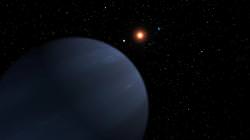Our Solar System has 8 planets, but another, 55 Cancri, is catching up fast. Astronomers today announced the discovery of a 5th planet in the system, located 41 light-years away. This newly discovered planet weighs in with 45 times the mass of the Earth, and might look similar to Saturn in composition and appearance. But the news gets better, it’s in the star’s habitable zone, and could have water-covered moons.
The discovery of a 5th planet around 55 Cancri was made by astronomers from UC Berkeley, and several other collaborating universities, with funding from NASA and the National Science Foundation. Their research will appear in an upcoming issue of the Astrophysical Journal.
Astronomers used the radial velocity technique to find the planets. This is where the velocity of the star is carefully measured. Periodic changes in this velocity mean that a large planet’s gravity is yanking the star back and forth. In this case, the discovery was even more difficult, because there were already known planets in the system, polluting the data.
“It is amazing to see our ability to detect extrasolar planets growing,” said Alan Stern, associate administrator for the Science Mission Directorate at NASA Headquarters, Washington. “We are finding solar systems with a richness of planets and a variety of planetary types comparable to our own.”
Perhaps the coolest part of this whole discovery: the planet orbits its parent star once every 260 days. This places it within its star’s habitability zone, where liquid water can be present. It’s a little closer than our Earth is to the Sun, but its star is also a little fainter, so it all evens out.
Obviously, this rules out the planet itself, but it could have a collection of moons, just like Saturn. Instead of Saturn’s icy moons, this 5th planet of 55 Cancri could have ocean moons.
Finding this planet was an enormous challenge. The discoverers have been making observations of 55 Cancri for 18 years, before the first extra solar planets were ever found. They had to make more than 320 velocity measurements to disentangle the 5 planets from the data.
Original Source: NASA/JPL News Release


It looks like a brief summary. Needs a little more information, though. Used as a site for a research paper.